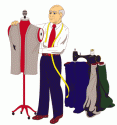Career Profile: Tailor/Dressmaker

When people go to a formal event like a banquet, they usually wear a nice suit or a dress. When they go to the lake, they put on swimsuits and wear shorts and t-shirts. What do all of these clothes have in common? They were all made by someone. In many places, some of the nicest clothes come from tailors or dressmakers. These experts in clothing make new suits, dresses, and other clothes or make alterations to customers’ clothes to make them as nice as possible. The job of tailor or dressmaker allows people to work with their hands and to be creative as they help people to get the kinds of clothes they want.
Many of the clothes that people wear come from factories where workers make hundreds of the same types of clothes to sell around the world. These clothes come in standard sizes and colours, and they are generally fairly inexpensive and casual. However, what about special clothes, like wedding dresses, graduation suits, or bridesmaids’ outfits? When people need something they can’t find in a store, they might go to get their outfits specially made.
Normally, tailors and dressmakers are not the people who design clothes. Instead, they follow premade patterns that they adapt to fit the person buying the clothes. They might also do alterations on clothes that people have bought elsewhere, such as raising or lowering the hems of pant legs or changing the size of a waistband. Whatever makes clothes more wearable is part of what tailors and dressmakers do. They often work with sewing machines but also have to know how to make clothes by hand. They have to be able to follow directions on patterns but also be flexible and creative to give customers the clothes they want.
Tailors and dressmakers need to know a lot about how clothes are designed. They need good skills in reading and mathematics to read and understand patterns and to make calculations to alter clothes. Generally, a high school diploma is enough to get into the work, although courses in home economics are useful. The most important thing is practice. With practice, people learn the different sewing terms and learn all kinds of techniques, such as making special stitches or working with different kinds of fabric. Generally, tailors work with men’s and boys’ clothes and dressmakers work with women’s and girls’ clothes, but not always.
Once they have the skills they need, tailors and dressmakers can work in all kinds of places. Some of them set up their own businesses in shops or in their homes. Others work in factories or in department stores. Some tailors and dressmakers work regular hours but make low wages, but experienced people in this field can often choose their own hours and make a lot of money. Getting to know the clients well and doing good work can help tailors and dressmakers succeed. If you like people and enjoy working with your hands, it could be the right job for you.





Leave a comment!